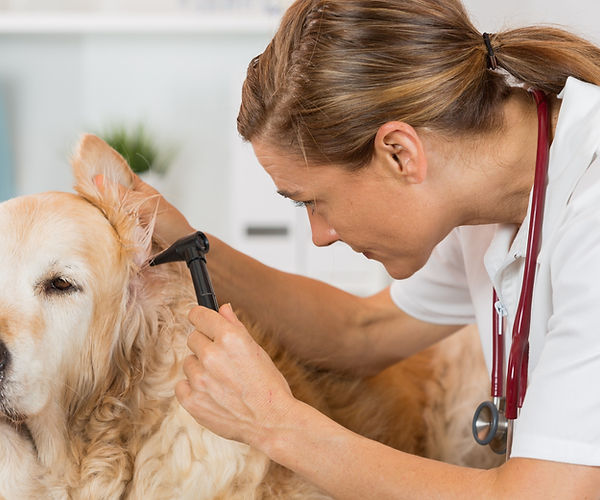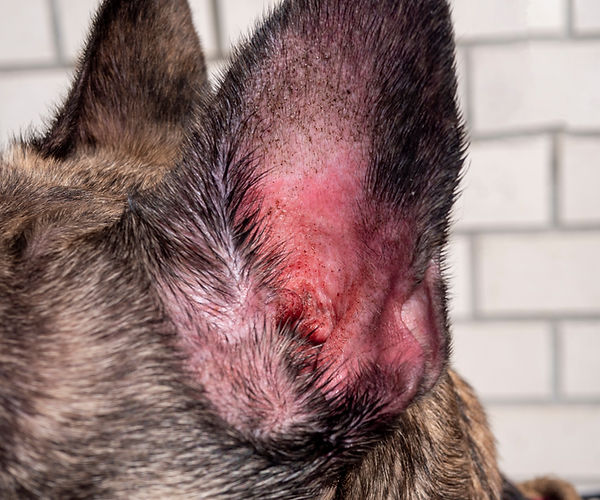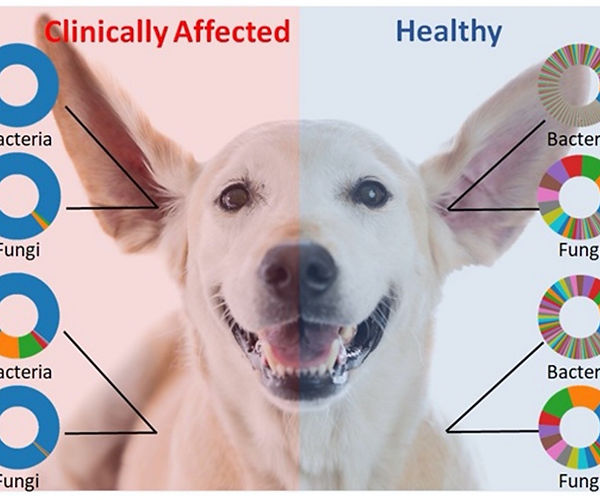
MiDOG technology can help properly diagnose your dog’s otitis externa infection.
Huh? What? Who’s a good boy? Odds are your dog’s hearing problems aren’t because they were listening to music too loud, but they may have an ear infection. Otitis externa (OE) is one of the most common ear diseases in canines and has a multifactorial etiology that is further complicated by secondary bacterial and/or yeast infections [1]. With the possibility of chronic OE causing hearing loss and even deafness, listen up and learn more about OE and its impact on your pup!
What is Otitis Externa?
With both acute and chronic presentations, otitis externa is a painful condition in which the external ear canal and ear pinna suffer inflammation [2]. Approximately 10-20% of dogs suffer from this condition in their lifetime, with symptoms including head-shaking, odor, increased discharge, redness, scratching, swelling, and scaly skin [2,3]. Moreover, physiological changes can occur in the external ear canal in response to chronic OE (persistent/recurrent otitis lasting 3 months or longer), including glandular hyperplasia, glandular dilation, epithelial hyperplasia, and hyperkeratosis [4]. The culmination of these physiological changes results in a cascade of consequences (increase in earwax production, pH, and humidity) that leaves your pup susceptible to recurrent infections [5].
Preventative measures are recommended to avoid recurrent OE infections, and so it is beneficial to understand the complex factors that contribute to your dog’s otitis externa. Veterinarians differentiate the causation of OE into four categories: primary factors, secondary factors, predisposing factors, and perpetuating factors. Identification of all four factors is key in order to ensure quality, targeted treatment for each unique OE presentation.

Inflammation and redness associated with otitis externa.
Predisposing Factors: While predisposing factors are not the sole cause of OE, the milieu they create increases the risk and persistence of OE infections. In the presence of primary and secondary factors, predisposing factors set the framework for otitis externa to proliferate [4].
- Ears with excessive hair
- Abnormal external ear canal and pinna conformation (such as congenital stenosis)
- Increased cerumen production in the canals
- Otic masses
- Frequent ear cleaning
- Changes in environmental temperature and humidity
Primary Factors: Primary factors are the catalysts that directly impact the ear canal’s epithelium, and consequently induce the inflammation associated with OE. Primary factor intervention is critical in order to avoid chronic otitis externa [4].
- Allergic disorders
- Endocrine disorders
- Foreign bodies
- Otic parasites (such as Otedectes cyanotis)
- Neoplasia
Secondary factors: When your dog’s ear is in a healthy state, the impact secondary factors have may be negligible. However, the conditions primary factors induce in a canine ear can allow secondary factors to flourish, and if not addressed can result in chronic OE [2].
- Yeast overgrowth (such as Malassezia)
- Bacterial overgrowth (such as Staphylococcus sp.)
Perpetuating factors: Otitis externa can induce physiological and anatomical changes in the ear, creating perpetuating factors. These factors can go on to exacerbate yeast and bacterial overgrowth, and ultimately must be addressed in order to avoid irreversible damage to your dog’s hearing. Perpetuating factors are one of the biggest culprits in non-response to treatment, and may necessitate surgical interventions [2].
- Ear canal/pinna fibrosis and stenosis
- Calcification of tissues
- Neoplasia (polyps, tumors, cysts)
Characterizing the Canine Aural Microbiome
If you think your dog may be suffering from otitis externis, please consult with a veterinarian as soon as possible. As has been previously mentioned, the multifaceted nature of this ear infection results in a complex diagnostics/treatment process that is only further complicated by delaying care. Consequently, having a solid understanding of the potential secondary bacterial and yeast presentations in your pup is crucial.
Increasing contemporary evidence has begun to acknowledge the shortcomings of culture-based diagnostic testing, as “the otic microbiome is much more complex than has been identified with previous culture-based studies” [1]. While previous culture-based studies have identified Staphylococcus pseudin-termedius, Pseu-domonas aeruginosa, Escherichia coli, Streptococcus sp., Enterococcus sp., and Corynebacterium as being associated with OE, several studies have revealed unculturable bacteria has been underestimated, while bacteria with high proliferation rates are possibly overestimated [3]. Recent advances in next-generation sequencing (NGS) technologies allow metagenomics analysis, and have provided exciting and practical opportunities for canine OE clinical interventions.
In one of the largest canine cohort studies to date, MiDOG NGS technology was recently used to analyze the bacterial and fungal microbiota in health and diseased ears. This study found that important taxa enriched in disease-state ears included Malassezia pachydermatis, Staphylococcus pseudintermedius, Staphylococcus schleiferi, and anaerobic bacteria such as Finegoldia magna, Peptostreptococcus canis, and Porphyromonas cangingivalis [3]. These findings are particularly notable, as the anaerobic microorganisms identified to be associated with canine ear infections have previously been overlooked by culture-based studies. The potential of NGS-based methods for the accurate quantification and identification of bacterial and fungal populations in diagnosing canine ear infections is remarkable and highlights the limitations of traditional culture-based testing.
If you would like to read the full study, please follow this link: https://www.sciencedirect.com/science/article/pii/S0378113519314932

Using MiDOG technology to perform a bacterial and fungal microbiome analysis of skin and ear samples of clinically affected and healthy dogs, the image above highlights higher microbial diversity in healthy state dogs than clinically affected dogs.
The MiDOG All-in-One microbiome test utilizes the NGS technology as described in the study to detect and quantify all microbial DNA through untargeted and comprehensive sequencing and quantitative comparisons to reference databases [2]. Considering shortcomings in culture-based diagnostics, the MiDOG NGS technology provides a useful opportunity to shed light on the microbial makeup of your dog’s aural microbiome for clinical application. The MiDOG microbiome test is a microbial identification test grounded on scientific research that provides veterinarians DNA evidence for the guided treatment of canine infections, such as otitis externa.

The MiDOG Swab Collection Kit can help diagnose your dog’s otitis externa infection.
Find out if your vet uses MiDOG before your next appointment!
References:
[1] Korbelik, J., Singh, A., Rousseau, J., & Weese, J. S. (2019). Characterization of the otic bacterial microbiota in dogs with otitis externa compared to healthy individuals. Veterinary Dermatology, 30(3), 228-e70. https://doi.org/10.1111/vde.12734
[2] Merck Veterinary Manual, & Woodward, M. (2020). Otitis Externa in Animals. Merck Veterinary Manual. https://www.merckvetmanual.com/ear-disorders/otitis-externa/otitis-externa-in-animals#:%7E:text=Otitis%20externa%20is%20inflammation%20of,examination%2C%20cytology%2C%20and%20culture.
[3] Tang, S., Prem, A., Tjokrosurjo, J., Sary, M., Van Bel, M. A., Rodrigues-Hoffmann, A., Kavanagh, M., Wu, G., Van Eden, M. E., & Krumbeck, J. A. (2020). The canine skin and ear microbiome: A comprehensive survey of pathogens implicated in canine skin and ear infections using a novel next-generation-sequencing-based assay. Veterinary Microbiology, 247, 108764. https://doi.org/10.1016/j.vetmic.2020.108764
[4] Bajwa J. (2019). Canine otitis externa – Treatment and complications. The Canadian veterinary journal = La revue veterinaire canadienne, 60(1), 97–99.
[5] Borriello, G., Paradiso, R., Catozzi, C., Brunetti, R., Roccabianca, P., Riccardi, M. G., Cecere, B., Lecchi, C., Fusco, G., Ceciliani, F., & Galiero, G. (2020). Cerumen microbial community shifts between healthy and otitis affected dogs. PLOS ONE, 15(11), e0241447. https://doi.org/10.1371/journal.pone.0241447
[6] Kasai, T., Fukui, Y., Aoki, K., Ishii, Y., & Tateda, K. (2020). Changes in the ear canal microbiota of dogs with otitis externa. Journal of Applied Microbiology, 0–10. https://doi.org/10.1111/jam.14868
Categories: Dogs, Ear Health, Next-Gen DNA Sequencing Technology, Pet Health, Safety and Wellness, Pet Parents
